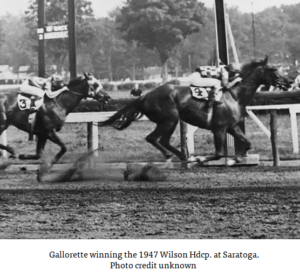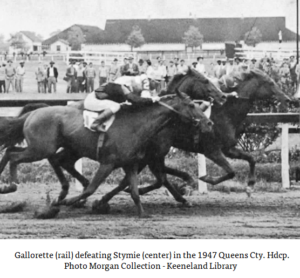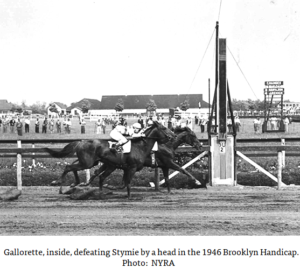Top Ten Fillies & Mares Twentieth Century
#6
Gallorette
(1944 – 1948)
Gallorette and jockey Eddie Arcaro after the 3-year-old filly won her first start against colts in 1945. The race was Gallorette’s first start of the year, a $4,000 allowance at Jamaica Race Track, and it was a prep for her next start, the Wood Memorial, in which she finished second to War Jeep.
Photo: Morgan Collection – Keeneland Library

PEDIGREE
Ch Filly
OWNER
W.L. Brann/Mrs. M. Moore
TRAINER
E.A. Christmas
BREEDER
Preston Burch


Some Facts
- Gallorette was another in a line of exceptional fillies and mares that graced North American race tracks in the 1940s. In a poll conducted by the Daily Racing Form to determine their picks for the greatest fillies and mares in the first half of the century, four were from the 1940s. They were led by Gallorette, who was foaled in 1942 and was voted #1. Following her were Twilight Tear (1941 – #2), Busher (1942 – #6), and Bewitch (1945 – #9). Others in the top ten were Regret (1912 – #3), Top Flight (1929 – #4), Miss Woodford (1880 – #5), Beldame (1901 – #7), Princess Doreen (1921 – #8), and Imp (1894 – #10).
- Gallorette was the result of a foal agreement. The 13-year-old mare Gallette, who was owned by Preston Burch, was a daughter of Sir Gallahad III. Mr. William Brann, who owned the 1940 Horse of the Year Challedon, wanted to buy Gallette and breed her to Challedon’s sire Challenger II, which was also owned in partnership by Brann but could not work out an agreement to purchase or lease her. Instead, Burch made him an offer, that being that they breed Gallette to Challenger II two years in a row, with Mr. Braun taking the first foal and Mr. Burch the other. The first foal born at Brann’s Glade Valley Farm near Frederick, Maryland, was Gallorette, who came into the world on February 7, 1942. While Gallorette would have a Hall of Fame career, the second foal, a filly named Galladare, would win just three of 18 starts and $9,200. Burch got some consolation when Galladare foaled a By Jimminy gelding named Martyr, which would win the 1950 Jerome Handicap.
- Challenger II was foaled in England in 1927 and was sired by Swynford, which won eight of its twelve-lifetime starts, including the ten-furlong St. Leger, the Eclipse, Hardwick Stakes (twice), Liverpool Summer Cup, and the Prince of Wales (all those stakes at twelve furlongs). Though not reaching the status of Chef de Race, Challenger II would sire thirty-four stake winners, with two destined for the hall of fame: Challedon, Horse of the Year in 1939 and 1940, and Gallorette.
- Gallorette was a big, rangy chestnut who grew to 16.1 hands at the beginning of her three-year-old season. She would race 72 times in a career that began in 1944 and ended in 1948. Fifty-three of her starts were against males, and she had a 12-15-9 record against them while being unplaced 17 times. When competing against fillies and mares, Gallorette made 19 starts, finished with a 9-5-4 record, and was unplaced just once.
- Gallorette won 13 stakes in total, nine of them against males and five against her own sex. Her stakes victories against males were the Whitney, Wilson (2X), Carter Handicap, Queens County Handicap, Bayshore, Brooklyn Handicap, Metropolitan Handicap, and the Empire City Handicap. Against fillies, she won the Beldame Handicap, Delaware Oaks, Pimlico Oaks (Black-Eyed Susan), and the Acorn.
- Though Gallorette won only 13 stakes in her 73-race career, she finished second in 17 others (seven by a neck or less) and was third in 10 others. She had a reputation for tackling the toughest competition. Among her competitors were champion Stymie, Pavot, which won the Belmont Stakes and Jockey Club Gold Cup, Double Jay, 1946 Triple Crown winner and Horse of the Year Assault, and the 1947 Horse of the Year Armed. She also ran once against Busher and finished third to the 1945 Horse of the Year in the 1944 Selima.
- Gallorette was only voted a champion once in her career, that being the champion older female in 1946. She holds the rare distinction of being voted into three separate Halls of Fame: The National Museum of Racing and Hall of Fame (1962), the Aiken Thoroughbred Hall of Fame (1977), and the Maryland Thoroughbred Hall of Fame 2015.
Links
DRF Past Performances:
Articles:
Slide Presentation
Tap on images for slide presentation in LIGHTBOX.






